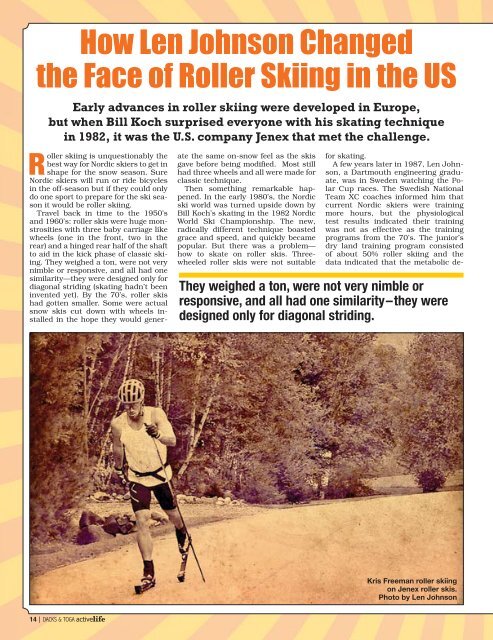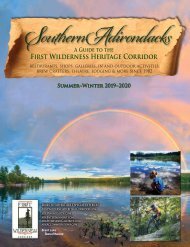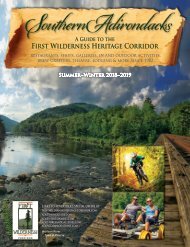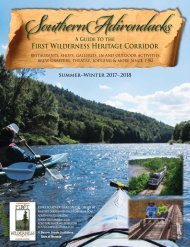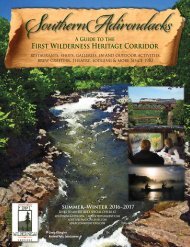Dacks and Toga Active Life August Issue For Web
Our August issue for living well in the Adirondacks of upstate New York. Sports, Fitness, Travel, Adventure, Wellness!
Our August issue for living well in the Adirondacks of upstate New York. Sports, Fitness, Travel, Adventure, Wellness!
You also want an ePaper? Increase the reach of your titles
YUMPU automatically turns print PDFs into web optimized ePapers that Google loves.
How Len Johnson Changed<br />
the Face of Roller Skiing in the US<br />
Early advances in roller skiing were developed in Europe,<br />
but when Bill Koch surprised everyone with his skating technique<br />
in 1982, it was the U.S. company Jenex that met the challenge.<br />
Roller skiing is unquestionably the<br />
best way for Nordic skiers to get in<br />
shape for the snow season. Sure<br />
Nordic skiers will run or ride bicycles<br />
in the off-season but if they could only<br />
do one sport to prepare for the ski season<br />
it would be roller skiing.<br />
Travel back in time to the 1950’s<br />
<strong>and</strong> 1960’s: roller skis were huge monstrosities<br />
with three baby carriage like<br />
wheels (one in the front, two in the<br />
rear) <strong>and</strong> a hinged rear half of the shaft<br />
to aid in the kick phase of classic skiing.<br />
They weighed a ton, were not very<br />
nimble or responsive, <strong>and</strong> all had one<br />
similarity—they were designed only for<br />
diagonal striding (skating hadn’t been<br />
invented yet). By the 70’s, roller skis<br />
had gotten smaller. Some were actual<br />
snow skis cut down with wheels installed<br />
in the hope they would generate<br />
the same on-snow feel as the skis<br />
gave before being modified. Most still<br />
had three wheels <strong>and</strong> all were made for<br />
classic technique.<br />
Then something remarkable happened.<br />
In the early 1980’s, the Nordic<br />
ski world was turned upside down by<br />
Bill Koch’s skating in the 1982 Nordic<br />
World Ski Championship. The new,<br />
radically different technique boasted<br />
grace <strong>and</strong> speed, <strong>and</strong> quickly became<br />
popular. But there was a problem—<br />
how to skate on roller skis. Threewheeled<br />
roller skis were not suitable<br />
They weighed a ton, were not very nimble or<br />
responsive, <strong>and</strong> all had one similarity–they were<br />
designed only for diagonal striding.<br />
Kris Freeman roller skiing<br />
on Jenex roller skis.<br />
Photo by Len Johnson<br />
for skating.<br />
A few years later in 1987, Len Johnson,<br />
a Dartmouth engineering graduate,<br />
was in Sweden watching the Polar<br />
Cup races. The Swedish National<br />
Team XC coaches informed him that<br />
current Nordic skiers were training<br />
more hours, but the physiological<br />
test results indicated their training<br />
was not as effective as the training<br />
programs from the 70’s. The junior’s<br />
dry l<strong>and</strong> training program consisted<br />
of about 50% roller skiing <strong>and</strong> the<br />
data indicated that the metabolic dem<strong>and</strong><br />
of using roller skis was about<br />
30% less than when skiing on snow.<br />
There was simply insufficient training<br />
stimulus for optimal fitness. With<br />
this information Len returned to the<br />
US with a mission—to design a roller<br />
ski that would be as close to simulating<br />
on-snow training as possible. Experimenting<br />
with different designs,<br />
Len sent a few prototypes to elite skiers<br />
in the United States <strong>and</strong> Sweden<br />
for testing. They were so well received<br />
that when he retired from his job at an<br />
electronics company, he began making<br />
V2 roller skis full-time. This was<br />
the beginning of Jenex, the Milford,<br />
AL: Where does the Jenex name<br />
come from?<br />
LJ: When I co-founded an electronics<br />
company the name was Genex. It<br />
became a successful company <strong>and</strong><br />
was acquired by Teradyne Inc. <strong>and</strong><br />
the name changed to Teradyne Connection<br />
Systems. Twenty-five years<br />
after founding Genex I started making<br />
roller skis <strong>and</strong> since my last name is<br />
Johnson decided to call it Jenex.<br />
AL: What other companies in the<br />
US were making roller skis at<br />
the time?<br />
LJ: No one.<br />
AL: Where did you get your<br />
inspiration for the look of the<br />
first V2?<br />
LJ: There was really no inspiration for<br />
the “look” of the roller skis. We wanted<br />
a very slow ski that would generate<br />
the same metabolic dem<strong>and</strong> as skiers<br />
training on a tough snow course <strong>and</strong><br />
we patented a kinematic damping device<br />
to increase rolling resistance <strong>and</strong><br />
also designed a super light frame.<br />
AL: Looking at other roller skis,<br />
what did you try to do better?<br />
LJ: To simulate snow skiing we increased<br />
the rolling resistance <strong>and</strong><br />
shortly thereafter introduced our<br />
popular Speed Reducers to make roller<br />
skiing safer <strong>and</strong> also provide variable<br />
rolling resistance.<br />
AL: Did others work with you on<br />
the original roller skis?<br />
LJ: No, I developed the roller skis<br />
from input from exercise physiologists<br />
<strong>and</strong> elite skiers.<br />
AL: Did you rely on other<br />
research that was available or<br />
did you do your own R & D?<br />
LJ: R&D was done in house. But the<br />
data from exercise physiologists <strong>and</strong><br />
comments from elite skiers was used<br />
to develop the flex <strong>and</strong> rolling resistance<br />
of the skis.<br />
AL: Where did you do the work—<br />
garage, basement, etc.?<br />
LJ: I still worked in the electronics<br />
Len sent a few prototypes to elite skiers in the<br />
United States <strong>and</strong> Sweden for testing.<br />
NH based company that manufactures<br />
some of the best skate <strong>and</strong> classic<br />
roller skis in the world.<br />
Jenex founder—octogenarian Len<br />
Johnson—took time out of his busy<br />
schedule to give us some insights<br />
about how Jenex changed the face of<br />
roller skiing. Len supplied <strong>Active</strong> <strong>Life</strong><br />
Magazine with the details from a study<br />
conducted by Anders Ek <strong>and</strong> supervised<br />
by Dr. Karin Piehl-Aulin where<br />
company when we made the first prototypes.<br />
Teradyne was one of the largest<br />
manufacturing companies in NH<br />
so I personally made the prototypes<br />
on equipment there. The first production<br />
units were made in my basement.<br />
I continued making them in the basement<br />
for several months then moved<br />
to a facility in Amherst, NH.<br />
AL: How hard was it to source<br />
parts you could not make yourself,<br />
for the first roller skis?<br />
LJ: We had a large manufacturing<br />
facility where I could build the prototypes.<br />
With the exception of the rubber<br />
tires we could make everything in<br />
house <strong>and</strong> I located a rubber manufacturer<br />
in Massachusetts who could<br />
make the tires. St<strong>and</strong>ard parts, such<br />
as bearings, bolts, nuts <strong>and</strong> screws<br />
could readily be purchased from<br />
many suppliers.<br />
AL: How long did it take to build<br />
your sales network in the US?<br />
Internationally?<br />
LJ: Because our skis were quite<br />
unique it went extremely quickly.<br />
Olympic <strong>and</strong> World Champion skiers<br />
immediately began to use our skis<br />
<strong>and</strong> it took less than two years.<br />
AL: Once you were ready to<br />
produce the first V2 roller skis,<br />
how many people were working<br />
at Jenex? How many are employed<br />
now?<br />
LJ: All custom parts are produced<br />
by local high technology manufacturing<br />
firms so Jenex only designs, tests<br />
<strong>and</strong> assembles the components. Only<br />
a few people work at Jenex <strong>and</strong> the<br />
number has been the same for over<br />
twenty-five years. If we produced the<br />
custom parts in house we would need<br />
equipment costing over two million<br />
dollars <strong>and</strong> about ten more employees.<br />
This is impossible to justify in<br />
such a small market as roller skis.<br />
AL: We underst<strong>and</strong> the “V2”<br />
connection, but what was the<br />
reason for the “Aero” part of the<br />
name <strong>and</strong> what are the benefits<br />
five skiers were tested on roller skis<br />
<strong>and</strong> snow skis over the same distance,<br />
<strong>and</strong> the same course (with snow <strong>and</strong><br />
without snow). The Jenex model used<br />
was the V2-910 (Jenex’ slowest classic<br />
ski) <strong>and</strong> the data proved remarkably<br />
similar, proving that his roller<br />
skis were able to accurately simulate<br />
on-snow skiing. <strong>Active</strong> <strong>Life</strong> magazine<br />
asked Len several questions about<br />
Jenex <strong>and</strong> his early roller skis:<br />
of large, pneumatic wheels?<br />
LJ: The Aero part was not used until<br />
we developed the pneumatic tires in<br />
1999. Skiing on snow is smooth, but<br />
skiing on solid rubber wheel roller skis<br />
can cause substantial vibration <strong>and</strong><br />
discomfort. The Aero tires dramatically<br />
reduce vibration. Other companies<br />
had tried pneumatic wheels before<br />
1999 but they were unreliable <strong>and</strong><br />
the companies stopped selling them.<br />
The 150 mm tires are extremely reliable<br />
<strong>and</strong> because they are pneumatic<br />
we dubbed them Aero. They are much<br />
safer since they can roll over debris<br />
that will cause smaller wheel st<strong>and</strong>ard<br />
roller skis to come to a sudden stop resulting<br />
in a fall. They are also smoother,<br />
more comfortable <strong>and</strong> the Patented<br />
Speed Reducers <strong>and</strong> Brakes are more<br />
effective on the pneumatic tire skis.<br />
AL: If you were given the chance<br />
to do things differently with<br />
Jenex, what would have done<br />
different?<br />
LJ: Would have invested in more<br />
manufacturing equipment for making<br />
prototypes. We have very powerful<br />
CAD programs, but only one CNC<br />
milling machine for building prototypes<br />
in-house. Producing prototypes<br />
on our supplier’s fiber-optic laser machines<br />
that costs over one million dollars<br />
makes the prototypes extremely<br />
expensive.<br />
AL: Where do you see roller ski<br />
design going in the future?<br />
LJ: We need to develop a very stable<br />
<strong>and</strong> easy to use roller ski that people<br />
with limited skiing skills can use.<br />
To make the ski safer <strong>and</strong> smoother<br />
it will utilize the pneumatic “Aero”<br />
wheels <strong>and</strong> Brakes <strong>and</strong> Speed Reducers<br />
will be st<strong>and</strong>ard. We have been<br />
working on the new design for over a<br />
year <strong>and</strong> expect to introduce it in the<br />
near future.<br />
<strong>Active</strong> <strong>Life</strong> Magazine thanks Len<br />
Johnson, Diane Bell <strong>and</strong> everyone at<br />
Jenex for helping us with this article<br />
during their busiest time of the year. n<br />
14 | DACKS & TOGA activelife<br />
DACKS & TOGA activelife | 15


